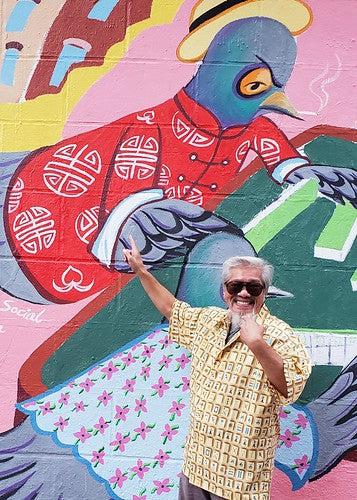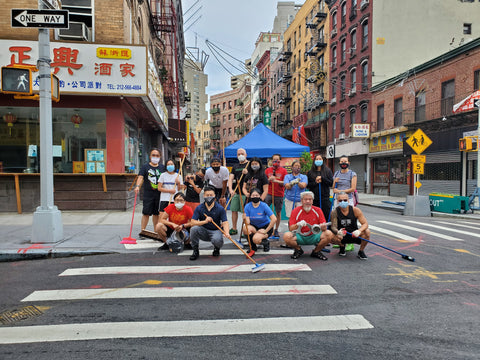
Community Activist Karlin Chan: Keeping Chinatown Alive and Kicking
Karlin Chan is a lifelong New Yorker, Chinatown resident, and community activist. He has always been driven to help his neighborhood, from the time he was a child holding festive flags for Lunar New Year lion dancing to these past several difficult months as the streets emptied due to xenophobia, the unhoused were left with nowhere to go, residents were harassed, and restaurants struggled to reopen. He has been there every step of the way and will continue to be there, making sure that Chinatown stays, not just alive, but alive and kicking.
We had the chance to speak with Karlin about growing up in the neighborhood, what it was like to be a lion dancer, what he’s been doing, and what he has planned.
Let’s start at the beginning. Tell me a little about your background. Where you were born and where you grew up.
My family moved to Chinatown when I was a toddler of two. I grew up in Chinatown and the mean streets of the Lower East Side so I’ve been in the neighborhood over 60 years now.
Have you always lived in New York?
In the mid-70s I moved to Cleveland for a couple of years. Then I came back in 1978. I lived in Queens for a while but I’ve always kept this same apartment [in Chinatown]. I’ve always paid the rent here.
That’s what drives me. I grew up in this neighborhood. I care deeply for it. I’ve been walking these streets for decades. My DNA is embedded in the sidewalks.
I read that you’ve been part of the Chinese Freemasons for a long time.
Yeah, I’ve been there over 50 years and still involved and very active with the organization. I started hanging around with them in 1969 or 1970. As a kid you would see the New Year lion dancing and fireworks. It was a great time. They always needed people to hold the flags and that was a way to feel part of the parade. They gave you $5 and dinner. So that’s how I got started
Did you also do lion dancing?
Oh yeah everyone does it eventually. I did it in the earlier '70s but I was mostly the drummer.
What’s it like in the lion costume? Is it hard work?
It was in a way but you did it because you wanted to learn the tradition. First you'd have to learn the different horse stances and condition your body for stamina to be able to play the lion head. It was more difficult then because you're inside the head and had no idea what an audience or spectator would see. Now you have cellphone video to help iron out the routine. Back then, the lion head was much heavier too. Now they’re fairly light. Maybe 10 pounds.

It’s reassuring to know the Chinatown Block Watch is out there looking out for residents. How did it get started?
It started with a few friends. Then it got on social media and other people wanted to get involved to do their part for the neighborhood. We'd patrol three times a week and took a very random route, winding our way around the whole neighborhood. In the beginning we'd even patrol towards Essex Street where many Chinese lived. Back in February, March, and April, the streets were empty and so, so quiet. That’s where most of the verbal harassment and muggings occurred. Now it’s different as businesses open. People call if they see an incident.
Is there a core group of volunteers?
There is a core group who commits their time on a regular basis to the Watch. When I started this back in late February or early March, people wanted to get out. They wanted to get involved after reading media reports and TV news reports of anti-Asian attacks because of Covid-19. Now as more businesses have reopened some have returned to work or simply plan a day with friends or family. It’s a volunteer basis and members patrol when they are available. There's no set minimum hours of participation. But we’re still going.

How can people join the Chinatown Block Watch?
Anyone wishing to join can send me an email at blockwatch@cfmac.org.
What’s a typical day like for you?
Earlier this year, it was very tiring. I usually wake up at 4 a.m. and go out early in the morning, about nine, get my coffee. I’d walk around the neighborhood to see if anything was happening. Then I’d go pack and prepare meals for the homeless. Back in February our streets were deserted. Then lockdown came and everything shut down. I was helping to feed the homeless and seniors.
The homeless Chinese tend to blend into the crowds in normal times . But with the pandemic they were made visible. I wrote about it in Bowery Boogie. They’re migrant workers and restaurant workers who had nowhere to go during lockdown. Pre-pandemic, they’d go to a casino or spend the night at an internet cafe. During the day, they’d sit in bakeries or the playground. At night they might find a bed or chair space. But with lockdown everything closed. With the streets empty, all you saw were homeless people. Some of them seniors. They started spending nights in Columbus Park, 70 or 80 people.
On top of that, I had Block Watch three days a week as well as feeding a homeless woman and her daughter in midtown. That was a nightmare because I had to take the train, but had my friend Grayson Chin accompanied me later and another friend Kristine drove us there. This went on for months.
Are you trying to take it easier now?
Yeah, I’m in my 60s so I’m trying to slow down. To take it easier and prepare for wave two this autumn that hopefully will never come. You can’t burn the candle at three ends indefinitely. My friends are always asking me, Why don’t you take a break?

But now you’re onto street sweeping.
During the first week of outdoor dining I was having dim sum and noticed the dirty streets, I thought I can’t eat out here, the freaking streets stink. [Laughs] The sanitation sweeper truck used to come down here and sweep the streets daily. But for four months alternate side parking was suspended so none of the streets were swept. Sanitation cut down on pickups. So I started the street sweeping thing every Saturday morning at 7:30 a.m. We have volunteers, open up the fire hydrants and scrub the streets down. It makes it more pleasant for people to eat.

How can people help out with that?
Anyone wanting to pitch in can meet us Saturdays at 7:30 a.m. on the corner of Bayard and Mott Streets.
Now you’re working on the Chinatown Mural Project.
I’m sitting here right now with the team and we’re planning our next mural. Resident artist Peach Tao is right across the room. We’re working to make Instagram spots. It’s art for recovery and about bringing people into the neighborhood. We hope to meet our fundraiser goals for supplies and artist stipends for future murals. We have two now, “Noodle Shop” and “Mahjong Social.”

I love “Mahjong Social”!
A lot of people do! The idea was to honor both the Chinese and Jewish roots of the neighborhood. Mahjong is very popular among the Jewish community too. They have clubs and tournaments.
How did you and Peach connect?
I do a lot of screaming and yelling on various issues facing our neighborhood and I had planned a rally to save 70 Mulberry Street. My friend who does videography mentioned a friend named Peach who does murals. I said something about adding dragons to the gate around the building, and boom boom boom, the dragons went up. I asked Peach if she was interested in doing Chinatown murals. She sent me a drawing and that was it! The #ChinatownMuralProject was born.
I had wanted for years to bring back murals into the neighborhood the way we had in the '70s and '80s. With Peach it's a perfect collaboration between artist and activist. We discuss what elements I'd like in the mural and she drafts a sketch. Then I show it to the building owner for approval.
Can you talk about the next mural?
The next one will be a Chinatown street scene. A mural that reflects the history and everyday life of the neighborhood. It will be like all our projects where both visitors and locals can relate to it.
I’m actually surprised no one has tagged the murals so far. Someone tagged the gate next to “Noodle Shop” but left the mural alone. That was pretty cool.
Do you have any particular memories about Pearl River since you grew up in the neighborhood around the same time Mr. Chen started the store in 1971?
I remember the original Pearl River on Catherine Street because my friend's father had the Wah Sun butcher shop a couple doors away. I'd stop in occasionally just to browse or whenever I needed a new padded Chinese jacket to wear during the winter.
Actually I've been in all the old locations. My friends and I used to hang out on Elizabeth Street by Grand where the Pearl River shop was next to the original Lendy's hardware store. But my favorite location was when Pearl River moved to the corner of Canal and Broadway.
Anything else you'd like to add?
I just want to say that I personally get nothing out of what I do. There’s no personal gain except satisfaction. I just want to keep the neighborhood from becoming a theme park Chinatown, like Vancouver or D.C. Sure, the Chinese art motifs are there but it's like a movie set. I want to keep this Chinatown going. It has shrunk over the years and will shrink after the pandemic. But I want to fight to keep it a functioning Chinatown, a place where people actually live and work.
Want to help? To contribute to the Chinatown Mural Project, check out their GoFundMe. For more information about New York Chinese Freemasons, email info@liondance211.org and for the Chinatown Block Watch, contact blockwatch@cfmac.org. To help with street sweeping, meet Karlin and the other volunteers Saturdays at 7:30 a.m. on the corner of Bayard and Mott Streets in Manhattan Chinatown.
